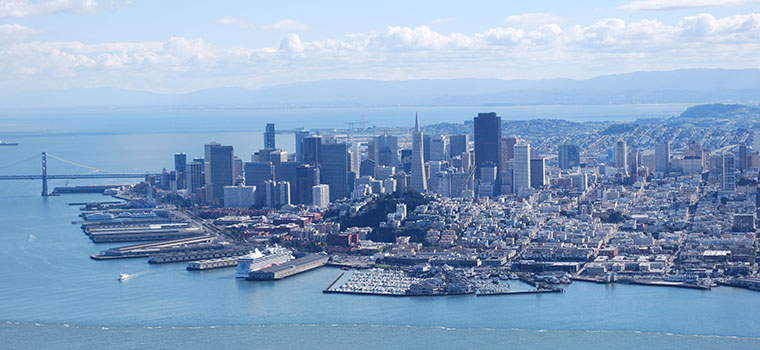New details have surfaced about Oakland's commitment to information technology upgrades, while the Port of San Francisco received a solid rating by Fitch last month.

The Port of San Francisco is unique in its ability to handle many types of cargo in an efficient way. The port recently received an “A” rating on over $52 million of revenue bonds.
BY PATRICK BURNSON
Published: April, 2018
New details have surfaced about Oakland’s commitment to information technology upgrades, while the Port of San Francisco received a solid rating by Fitch last month.
In Oakland, port officials have promised a digital shipping platform by mid-year to speed up global trade flows. According to port spokespeople, Oakland is building an online portal for transactions that range from tracking to transporting containerized cargo. The move aligns with an industry migration toward digitalization of international supply chains for the sake of efficiency.
The port previewed its portal—called a digital collaboration platform—at an American Association of Port Authorities meeting in Oakland last month. Port officials said the portal will provide a single window for cargo owners or freight haulers who want to: get personalized cargo status updates; check ocean vessel schedules; pay freight-handling fees; or make appointments to pick up containerized cargo.
“This is the next big thing in global trade,” said Port of Oakland Senior Project Administrator Eric Napralla. “It’s a common platform—one place where everyone can go to more easily view and direct their shipments.”
Development of the portal is already underway and it will roll out in phases, the port said. It projected a third-quarter 2018 launch date for the site. Oakland is working with New Jersey-based logistics software provider Advent Intermodal Solutions to create the portal. The firm’s eModal port community system is already used by every marine terminal operator at the port. That common use will make it easier to roll out the new platform, the port explained.
Terminals are the “pivot point” of containerized trade, where ocean vessels, trucks and trains converge to transport cargo. According to the port, Advent will aggregate information from Oakland’s four terminals to create a harbor-wide community portal.
Speculation that more “Uber-like” drayage models might take advantage of this development has yet to become reality, however. “Not hearing much discussion about that here,” said Mike Zampa, the port’s communications director. “But a digital information platform across the entire Port of Oakland will make supply chain management more efficient. There’ll be greater predictability in cargo flow and less wasted time for those who transport cargo.”
Ports nationwide are considering digital portals to accelerate freight transport. Oakland said it intends to be one of the first to go live with the new technology. It could also be one of the few with an online portal that’s used by every terminal operating within a port.
The port said shippers would be better able to manage international supply chains once its portal is in place. For example, cargo owners would know with greater precision when to expect merchandise. Trucking companies would know exactly when and where to dispatch drivers for container pick-up. Marine terminals would benefit from more efficient movement of cargo in and out of the port.
“They’ll only log in to the portal once,” Napralla said. “Then they can navigate the entire port with a few simple clicks.”
Port of San Francisco Nabs “A” Rating for Bonds
Fitch Ratings has affirmed the “A” rating on $52.86 million of revenue bonds of the Port Commission of the City and County of San Francisco, adding that the port’s rating outlook is “stable.”
Investment analysts also noted that the port has outstanding subordinate obligations in the form of certificates of participation issued by the city, and a loan from the California Department of Boating and Waterways, neither of which are rated by Fitch.
According to Fitch, the port is “working more aggressively” to address its sizeable backlog of deferred maintenance needs. Fitch notes the nature of the capital plan prioritizes revenue generating assets, identifying non-revenue generating assets that could be shut down if needed, thereby reducing capital needs.
The port estimates that, for the years 2018 to 2027, its facilities require approximately $1.5 billion to maintain a state of good repair and $562 million for conditional seismic work. The majority of state of good repair financing currently remains unidentified, but relates to sources not critical from a revenue generating perspective.
The Port of San Francisco is unique in its ability to handle many types of cargo in an efficient and cost effective way. Pier 80’s auto-processing terminal is ideally located to serve the large network of car dealerships in Northern California. Several harbor and cargo service facilities are located near the port’s terminals, offering easy access to tug and barge companies, heavy lift crane services, a Foreign Trade Zone, cold storage, warehousing and full-service ship repair.
Patrick Burnson is the executive editor of Logistics Management. www.logisticsmgmt.com

